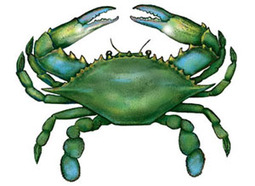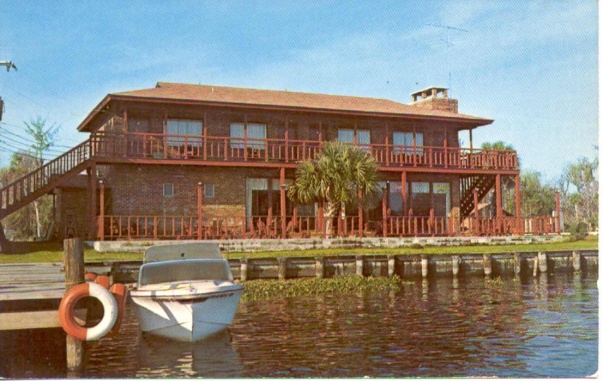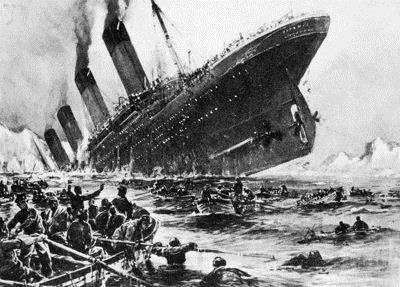News - from Yesterday & Today
1957 Florida News Journal Article on St. Johns River
 Blue Crabs of the St. Johns River.
Blue Crabs of the St. Johns River.
One of Astor’s many assets is the delicious Blue
Crab. The major export of the
crabs are mostly caught around the
brackish areas of Lake George and some areas of the St. Johns River.
The harvesting of the Blue Crab faded before the turn of the calendar in
1900.
But the People are still there in Astor., and the
people there are the glue and mortar of any community’s survival and existence.
The Lees, the Lucases and the Sauls are still there and around them the town grows as more and more people find it on their maps.
It has been in the last five years or so that the outside world has turned its money and attention to Astor. The Blackwater Inn
Restaurant is one ideal example.
No longer a motel, the two story brick building sits on the rivers edge and serves up the local shrimp, fish and crab. The
second floor has been converted into a lounge and the restaurants staff has gone from four employees in 1971 to 23.
The menu is typically blue crabs for $4.75 on up and Surf and Turf entrees for $11.75.The Blackwater is the probably the most idylistic spot in Astor. A diner can be set under the Canopied porch and sup and sip and watch the
hyacinths slide by in the rain tap-taps on thecanvas overhead. There is always life on the river, unfolding in a panorama : a natural stage show for diners as motorboats herd the lazy islands like cowboys working cattle.
Crab. The major export of the
crabs are mostly caught around the
brackish areas of Lake George and some areas of the St. Johns River.
The harvesting of the Blue Crab faded before the turn of the calendar in
1900.
But the People are still there in Astor., and the
people there are the glue and mortar of any community’s survival and existence.
The Lees, the Lucases and the Sauls are still there and around them the town grows as more and more people find it on their maps.
It has been in the last five years or so that the outside world has turned its money and attention to Astor. The Blackwater Inn
Restaurant is one ideal example.
No longer a motel, the two story brick building sits on the rivers edge and serves up the local shrimp, fish and crab. The
second floor has been converted into a lounge and the restaurants staff has gone from four employees in 1971 to 23.
The menu is typically blue crabs for $4.75 on up and Surf and Turf entrees for $11.75.The Blackwater is the probably the most idylistic spot in Astor. A diner can be set under the Canopied porch and sup and sip and watch the
hyacinths slide by in the rain tap-taps on thecanvas overhead. There is always life on the river, unfolding in a panorama : a natural stage show for diners as motorboats herd the lazy islands like cowboys working cattle.
No longer a motel, the two story brick building
sits on the rivers edge and serves up the local shrimp, fish and crab. The
second floor has been converted into a lounge and the restaurants staff has gone
from four employees in 1971 to 23.
The menu is typically blue crabs for $4.75 on up and Surf and Turf entrees for $11.75.
The Blackwater is the probably the most idylistic spot in Astor. A diner can be set under the
Canopied porch and sup and sip and watch the hyacinths slide by in the rain tap-taps on the
canvas overhead. There is always life on the river, unfolding in a panorama : a natural stage show for diners
as motorboats herd the lazy islands like cowboys working cattle.
sits on the rivers edge and serves up the local shrimp, fish and crab. The
second floor has been converted into a lounge and the restaurants staff has gone
from four employees in 1971 to 23.
The menu is typically blue crabs for $4.75 on up and Surf and Turf entrees for $11.75.
The Blackwater is the probably the most idylistic spot in Astor. A diner can be set under the
Canopied porch and sup and sip and watch the hyacinths slide by in the rain tap-taps on the
canvas overhead. There is always life on the river, unfolding in a panorama : a natural stage show for diners
as motorboats herd the lazy islands like cowboys working cattle.
And the lights of Hall’s Marina sparkle off the low ripples of the river in dancing yellow patterns.
A meal of 6 blue crabs is a patently patient way of dining. One uses as much energy, it seems, cracking the
claws and treasure hunting for the delicate white meat as calories consumed , and there is a growing,
nagging appreciation for the simplicity of an eggshell.
The river, and its silent vestages of verdant life, hypnotizes, recalling the agelessness of life along
the St. Johns.
The Astor area was an active place during prehistoric times. This point on the St. Johns was a major fording
site, lying shallow and barely five miles south of Lake George. The first bridge wasn’t’
built until 1928m and now the shallows are gone and few traces of the river bank’s early inhabitants remain.
But once, the shallow water provided not only a fording point, but a place for aboriginal tribes to rest and camp, a place where main diet staples were easy to obtain–ampullaria (apple snail) and paludinae (a mollusk). Today, on the west bank of the St. Johns, were SR 40 turns west from its route along the River, there is a shell mound that is approximately 40 feet
in diameter and about 7 feet high, running from the rim of the water”s edge, a mound of countless snail shells.
Some Astor residents argue the point, although there is no official town historian, but the
Florida Board of Parks and Historical Memorials has thoughtfully erected a metal sign telling anyone who
pauses on the way through that Ft. Butler rested near this mound, on the west
bank, built in 1838 during the Seminole Wars. Made of crude stockade and barracks for the garrison,
The fort was one of the military installations designed to protect the St. Johns River, which in turn served as an
important artery of communication.
A meal of 6 blue crabs is a patently patient way of dining. One uses as much energy, it seems, cracking the
claws and treasure hunting for the delicate white meat as calories consumed , and there is a growing,
nagging appreciation for the simplicity of an eggshell.
The river, and its silent vestages of verdant life, hypnotizes, recalling the agelessness of life along
the St. Johns.
The Astor area was an active place during prehistoric times. This point on the St. Johns was a major fording
site, lying shallow and barely five miles south of Lake George. The first bridge wasn’t’
built until 1928m and now the shallows are gone and few traces of the river bank’s early inhabitants remain.
But once, the shallow water provided not only a fording point, but a place for aboriginal tribes to rest and camp, a place where main diet staples were easy to obtain–ampullaria (apple snail) and paludinae (a mollusk). Today, on the west bank of the St. Johns, were SR 40 turns west from its route along the River, there is a shell mound that is approximately 40 feet
in diameter and about 7 feet high, running from the rim of the water”s edge, a mound of countless snail shells.
Some Astor residents argue the point, although there is no official town historian, but the
Florida Board of Parks and Historical Memorials has thoughtfully erected a metal sign telling anyone who
pauses on the way through that Ft. Butler rested near this mound, on the west
bank, built in 1838 during the Seminole Wars. Made of crude stockade and barracks for the garrison,
The fort was one of the military installations designed to protect the St. Johns River, which in turn served as an
important artery of communication.
Updated Story concerning the Titanic Sinking
We’ve had compelling Titanic survivor accounts from the likes of Molly Brown and
Elizabeth Shutes and, of course, Kate Winslet’s fictional (though adored)
onscreen character. Now comes one from French passenger Rose Amélie Icard, whose
letter containing eyewitness details of the disaster has emerged on Reddit,
causing a stir among history lovers. (see actual letter below)
My most tragic memory of my seventeen year trip around the world is the Titanic
sinking. I'm 83 year old, but it is an hour [a moment] of my life that I will
never forget. I was in Paris when I've met, through a friend interpreter, Mrs
George Stone, widow of an American, president of the Bell Cie [it's a Canadian
company, for what I know, anyway], the general telephone Cie, who was looking
for a person enjoying travelling to accompany her.
My lifelong dream was about to be fullfilled : I decided to go with her to America.
I can't list... all the countries where we have been.
In winter 1912, we were in Egypt; our travel went on to the Holy Land and ended in
Jerusalem.
That unforgettable travel to Jesus' country came very close to be the last of them
all.
Back in Europe, after having been in Paris and London, we boarded on the Titanic on
April 10th 1912.
It was Mrs. Stone who got the tickets in London, and told me, delighted, that
we would board on the nicest liner.
The preceding nights, I had dreamed about death, ripped open trunks : a
pressentiment, maybe, made me tell [to myself] that I should not have choosen
the Titanic.
The Commander Smith, even if he was about to retired, was choosen by the White Star
Line to drive this floating palace for his its first travel; I can still see
him, a handsome old man with a white beard. It is him he himself who helped me to
get in the lifeboat.
During the four days that lasted the short-lived [fare?] of this splendid transatlantic
liner, it was all about celebrations, ceremonial dinners of royal luxury, the
toilets clothes dresses [were] somptuous sumptuous, it was a display of shining
jewels and of rivers of diamonds worthy of an oriental
splendour.
edit: Jesus, people, thanks for the gold! ;)
Elizabeth Shutes and, of course, Kate Winslet’s fictional (though adored)
onscreen character. Now comes one from French passenger Rose Amélie Icard, whose
letter containing eyewitness details of the disaster has emerged on Reddit,
causing a stir among history lovers. (see actual letter below)
My most tragic memory of my seventeen year trip around the world is the Titanic
sinking. I'm 83 year old, but it is an hour [a moment] of my life that I will
never forget. I was in Paris when I've met, through a friend interpreter, Mrs
George Stone, widow of an American, president of the Bell Cie [it's a Canadian
company, for what I know, anyway], the general telephone Cie, who was looking
for a person enjoying travelling to accompany her.
My lifelong dream was about to be fullfilled : I decided to go with her to America.
I can't list... all the countries where we have been.
In winter 1912, we were in Egypt; our travel went on to the Holy Land and ended in
Jerusalem.
That unforgettable travel to Jesus' country came very close to be the last of them
all.
Back in Europe, after having been in Paris and London, we boarded on the Titanic on
April 10th 1912.
It was Mrs. Stone who got the tickets in London, and told me, delighted, that
we would board on the nicest liner.
The preceding nights, I had dreamed about death, ripped open trunks : a
pressentiment, maybe, made me tell [to myself] that I should not have choosen
the Titanic.
The Commander Smith, even if he was about to retired, was choosen by the White Star
Line to drive this floating palace for his its first travel; I can still see
him, a handsome old man with a white beard. It is him he himself who helped me to
get in the lifeboat.
During the four days that lasted the short-lived [fare?] of this splendid transatlantic
liner, it was all about celebrations, ceremonial dinners of royal luxury, the
toilets clothes dresses [were] somptuous sumptuous, it was a display of shining
jewels and of rivers of diamonds worthy of an oriental
splendour.
edit: Jesus, people, thanks for the gold! ;)





